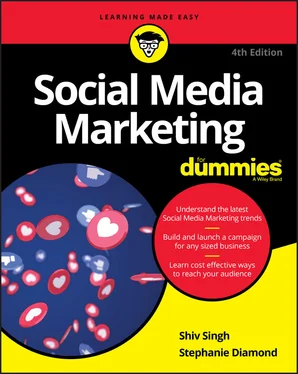3 Part 1: Getting Started with Social Media Marketing Part 1
Chapter 1: Understanding Social Media Marketing Chapter 1
Defining Social Media Marketing Defining Social Media Marketing A discussion of any subject needs to begin with a definition, and so here’s the one for social media marketing: Social media marketing (SMM) is a technique that employs social media (content created by everyday people using highly accessible and scalable technologies such as social networks, blogs, micro-blogs, message boards, podcasts, social bookmarks, communities, wikis, and vlogs). Social media (which has probably been one of the most hyped buzzwords of the last decade) refers to content created and consumed by regular people for each other. It includes the comments a person adds at the end of an article on a website, the family photographs she uploads to a photo-sharing service, the conversations she has with friends in a social network, and the blog posts she publishes or comments on. That’s all social media, and it’s making everyone in the world a content publisher and arbitrator of content. It’s democratizing the web. Facebook, shown in Figure 1-1, is the most popular social network. It allows you to connect with friends and share information in a matter of minutes. Facebook has 2.41 billion monthly active users around the world. FIGURE 1-1: Facebook is just one example, albeit the largest, of the many media platforms.
Learning about the Roles People Play Learning about the Roles People Play To look at the framework of social media marketing, we need to look at the different roles played by those engaged in social media. They are as follows: Marketers: They publish and share content online to achieve an organization’s marketing and business needs. Today’s marketer looks nothing like the marketers of the twentieth century. Customers now own the brand conversation. The opportunity to interrupt and annoy those customers has dwindled. Customers now meet businesses on their own terms. In the following section, we discuss the new role that marketers have to play. Influencers: Several types of influencers contribute to the decisions customers make. They may be everyday people who influence the consumer as he makes a purchasing decision. Depending on the decision, the social influencers may be a wife (or husband), friends, peers at work, or even someone the consumer has never even met in real life. Simply put, the people who influence a brand affinity and purchasing decision are the social influencers. They may exert this influence directly by rating products and commenting or by publishing opinions and participating in conversations across the web. Anyone can be a social influencer, influencing someone else’s brand affinity and purchasing decisions, and you, the reader, are probably one, too, without realizing it. We discuss the specific types of influencers in the section “ Understanding the role of the influencer .” Platforms: We used to believe that the social media platforms on which marketers, influencers, and consumers published content were neutral technologies without playing a role in whose content got promoted and shared the most. However, in recent years, the actions of the major social media platforms have shown that their leadership has an active role to play in what gets promoted, shared, and inversely censured on a social media marketing platform. If you’re a small company, their influence may not be noticeable but for larger companies who market and sell many products online, understanding how the platforms and their leaders think about content is important. It isn’t enough to market to the consumer anymore; as a marketer, you have to market to your potential customers’ social influencers as well so that they, in turn, influence either overtly or just by what they publish and share online. And that’s what social media marketing is about.
Comparing Social Media Marketing with Other Marketing Efforts Comparing Social Media Marketing with Other Marketing Efforts It isn’t enough to deploy social media marketing in isolation of every other marketing effort. If you do, you’re sure to fail. Your customers will notice that you have a disjointed, conflicted story — depending on where and how you’re interacting with them. Therefore, it’s important to understand how you can integrate your social media marketing within your other, more traditional marketing — direct mail, public relations, display advertising, and promotions. Some of the social media marketing philosophies are in conflict with traditional public relations, media buying, direct mail, and promotions tactics. It’s no use damning those forms of marketing and alienating your peers who focus on those areas. Put extra effort in partnering with your fellow employees as you practice these marketing techniques. Explain what you’re doing, why you’re doing it, and how it complements their efforts. If you discredit the other forms of marketing and the people behind them, it only hurts you in the long run.
Taking Social Influence Beyond Marketing Taking Social Influence Beyond Marketing As we hint in the earlier sections, the benefits of social media marketing extend beyond the core domain of marketing. If you harness the power of social influence marketing to change other parts of your business, you stand to gain the most. You can use SMM to mobilize groups of people to take specific actions, make marketers better corporate citizens, and further social change — and through those efforts, enhance a brand, too.
Chapter 2: Discovering Your SMM Competitors Chapter 2
Classifying Consumer Activities Researching Your Customers’ Online Activities Identifying Personas Analyzing Competitor Efforts Researching Your Competitors’ Campaign Support Dipping into Hot SMM Concepts Chapter 3: Getting in the Social Media Marketing Frame of Mind Putting SMM in the Context of the Marketing Funnel Deepening Your SMM Relationship Treating SMM Differently from Brand Marketing
4 Part 2: Practicing SMM on the Social Web Chapter 4: Launching SMM Campaigns Discovering the Types of SMM Campaigns Recognizing What Makes a Good SMM Campaign Creating Your SMM Roadmap Participating — Four Rules of the Game Killing the Campaign Expiry Date Monitoring Brands and Conversations Responding to Criticism Chapter 5: Developing Your SMM Voice Figuring Out Why You Need an SMM Voice Defining SMM Voice Characteristics Distinguishing Between SMM Voices and Brand Voices Outlining SMM Voice Objectives Choosing the Owner of Your Organization’s SMM Voice Crowdsourcing SMM Voices with Guidelines Chapter 6: Understanding a Marketer’s Responsibilities Recognizing Who You Serve Practicing Socially Responsible Marketing Accountability to Your Own Company
5 Part 3: Reaching Your Audience via Mainstream Social Platforms Chapter 7: Finding the Right Platforms Choosing Social Media Platforms Preparing Your Employees for Social Media Networking Evaluating Your Resources Assessing What Each Social Network Offers You Chapter 8: Exploring SMM Strategies for Facebook Looking at Facebook Basics Using Ads on Facebook Chapter 9: Marketing on Twitter Figuring Out the Basics of Twitter Marketing via Twitter Using Promoted Accounts Making Use of Promoted Tweets Using Promoted Trends Working with Sponsored Tweets Tips and Tricks Chapter 10: Creating a YouTube Strategy Looking at YouTube Basics Promoting on YouTube Seeding a Viral Campaign Advertising on YouTube Chapter 11: Considering LinkedIn Getting Started Creating a New Profile Participating in Groups Using LinkedIn to Answer Questions Finding a Job Chapter 12: Delving into Instagram Recognizing the Basics Getting Found on Instagram Structuring Instagram for Business Goals Chapter 13: Discovering Snapchat Exploring Snapchat Advertising on Snapchat Measuring Results on Snapchat Chapter 14: Marketing with Pinterest Recognizing Pinterest Users Focusing on Strategy Becoming a Business Pinner Developing Credibility with Your Boards and Images Chapter 15: Interacting with Tumblr Setting Up Shop on Tumblr Finding and Sharing the Good Stuff Looking at Paid Media Tracking Your Users Chapter 16: Engaging Customers Using Other Platforms Blogging on Medium for Your Business Discussing Ideas On Reddit.com Sharing Video on TikTok
Читать дальше












